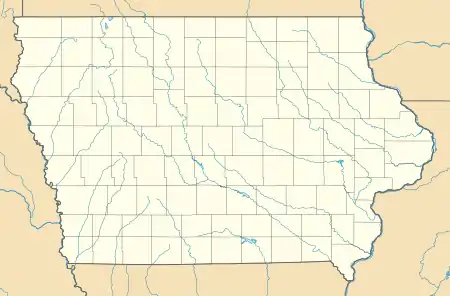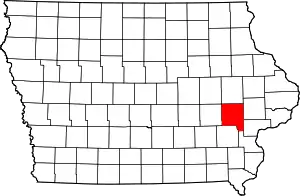Iowa Federation of Colored Women's Clubs
The Iowa Federation of Colored Women's Clubs (IFCWC) was an umbrella organization serving African-American women's clubs in Iowa. The motto of IFCWC was "Sowing Seeds of Kindness," and the organization was affiliated with the National Association of Colored Women.[2] The club produced a journal called the Iowa Colored Woman.[3] IFCWC sent delegates to represent the state at national conventions and opportunities such as "Colored Women's day" at the 1939 New York World's Fair.[4] The IFCWC is also known for creating a black women's dormitory for the University of Iowa before the school was fully integrated. The building has been listed on the National Register of Historic Places.
Iowa Federation Home for Colored Girls | |
  | |
| Location | 942 Iowa Ave. Iowa City, Iowa |
|---|---|
| Coordinates | 41°39′41″N 91°31′16″W |
| Area | less than one acre |
| NRHP reference No. | 82000412[1] |
| Added to NRHP | December 6, 2019 |
About
The IFCWC was created in May 1902[5] and was at first known as the Iowa Association of Colored Women's Clubs.[6] The first convention met in Ottumwa with only a few women and their clubs attending.[7] The first president was Helen Downey.[8] By 1904, there were 300 women attending the annual conference and clubs from all cities large enough to support them sent representatives.[7] By 1914, the IFCWC represented 40 different African-American women's clubs in Iowa.[9] Also in that year, the IFCWC created a committee dedicated to women's suffrage, which was headed by Teresa Adams.[6]
Iowa Federation Home for Colored Girls
In 1912, it was proposed by the president of IFCWC, Mrs. J.B. Rush, that a home for black working women be established.[10] In 1919, the IFCWC purchased a home, known later as the "Federation Home," at 942 Iowa Avenue in Iowa City.[11] White neighbors protested the sale of a house to African Americans, successfully demanding that the lot's price be reassessed, causing IFCWC to pay more money for their purchase.[12] In 1934, the home was renamed "Sue Brown Hall" after a prominent member of the IFCWC.[13] The home allowed black women who wanted to attend the University of Iowa to have a place to stay, since they were not allowed in the dorms until 1947.[14] The home closed in 1950.[11] The building is protected as a local landmark in Iowa City, and it was listed on the National Register of Historic Places in 2019.[15][1]
References
Citations
- "National Register of Historic Places - Weekly List". National Park Service. December 13, 2019. Retrieved 2019-12-14.
- Breaux 2002, p. 238.
- "Afro-American Happenings". The Des Moines Register. 18 January 1910. Retrieved 15 May 2017 – via Newspapers.com.
- "Mason City Woman Elected Leader of Colored Group". The Mason City Globe-Gazette. 29 June 1939. Retrieved 16 May 2017 – via Newspapers.com.
- "A Colored 'Fed'". The Minneapolis Journal. 26 April 1902. Retrieved 15 May 2017 – via Newspapers.com.
- "Women's Suffrage in Iowa: An Online Exhibit". Iowa Women's Archives. The University of Iowa Libraries. 2011. Retrieved 16 May 2017.
- "Honor Mrs. Horace Graves". The Des Moines Register. 3 June 1904. Retrieved 15 May 2017 – via Newspapers.com.
- "The Author". The Pittsburgh Courier. 27 April 1940. Retrieved 15 May 2017 – via Newspapers.com.
- "Iowa Women's Federation". The Bystander. 29 May 1914. Retrieved 15 May 2017 – via Newspapers.com.
- "Colored Girls' Home to Be Built". The Des Moines Register. 31 May 1912. Retrieved 15 May 2017 – via Newspapers.com.
- "African American Women Students at the University of Iowa 1910-1960". The University of Iowa Libraries. 2009. Retrieved 16 May 2017.
- Breaux 2002, p. 242.
- Breaux 2002, p. 239.
- Boylan, Peter (18 April 2001). "This Old House: An Isle of Pride, Acceptance". Daily Iowan. Retrieved 16 May 2017 – via University of Iowa Libraries.
- Arnold, Madison (21 January 2017). "Two Historic University of Iowa Dorms Receive Civil Rights Grant". The Gazette. Retrieved 16 May 2017.
Sources
- Breaux, Richard M. (Spring 2002). "'Maintaining a Home for Girls': The Iowa Federation of Colored Women's Clubs at the University of Iowa, 1919-1950". The Journal of African American History. 87: 236–255. doi:10.2307/1562465. JSTOR 1562465.CS1 maint: ref=harv (link)
External links
- IFCWC convention schedule, 1910
- Proceedings of the Eighteenth Annual Session of the Iowa Federation of Colored Women's Clubs, 1919
- Iowa Federation Home, 1929
